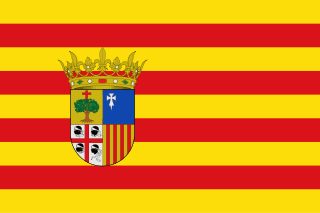
Aragon is an autonomous community in Spain, coextensive with the medieval Kingdom of Aragon. In northeastern Spain, the Aragonese autonomous community comprises three provinces : Huesca, Zaragoza, and Teruel. Its capital is Zaragoza. The current Statute of Autonomy declares Aragon a historic nationality of Spain.

Huesca is a city in north-eastern Spain, within the autonomous community of Aragon. It is also the capital of the Spanish province of the same name and of the comarca of Hoya de Huesca. In 2009 it had a population of 52,059, almost a quarter of the total population of the province. The city is one of the smallest provincial capitals in Spain.

Sesa is a municipality located in the Hoya de Huesca comarca, province of Huesca, Aragon, Spain. According to the 2010 census the municipality has a population of 225 inhabitants. Its postal code is 22110.
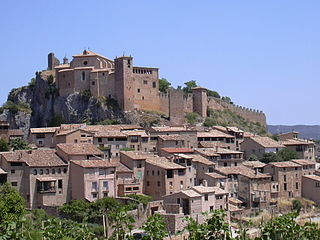
Alquézar is a municipality in the province of Huesca, in the autonomous community of Aragon, Spain. As of 2012, its population was 301.

The Diocese of Jaca is an episcopal see in the northeastern Spanish province of Huesca, part of the autonomous community of Aragón. The diocese is subordinate to the Archdiocese of Pamplona y Tudela.
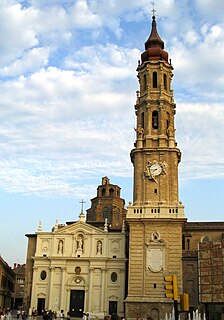
The Archdiocese of Saragossa is a Roman Catholic ecclesiastical territory located in north-eastern Spain, in the province of Zaragoza, part of the autonomous community of Aragón. The archdiocese heads the ecclesiastical province of Saragossa, having metropolitan authority over the suffragan dioceses of Barbastro-Monzón, Huesca, Tarazona, and Teruel and Albarracín.

Somontano is a Spanish Denominación de Origen Protegida (DOP) for wines, created in 1984, and located in the county of the same name, in the province of Huesca,. It borders the regions of Sobrarbe and Ribagorza in the North, Hoya de Huesca in the West, the Monegros in the South, and the region of Litera in the East. Wine production is centred on the town of Barbastro. The name Somontano, as its Latin roots suggest, means “beneath the mountain” – this perfectly defines this geographic area which spreads out from the foothills of the Pyrenees down to the Ebro valley. The DOP includes 43 municipalities, most of them in the Somontano area, and a few bordering on Ribagorza and the Monegros. There are over 4000 hectares of vines and about 500 individual grape-growers.
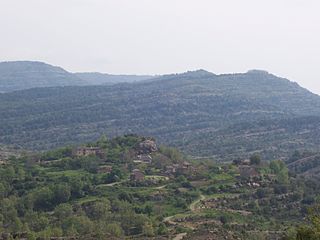
Used is a deserted village under the local government of the municipality of Sabiñánigo, Alto Gállego, Huesca, Aragon, Spain.
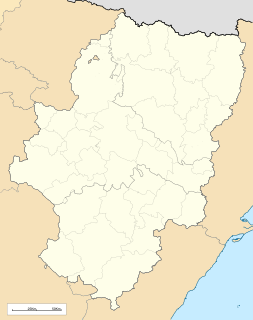
Bierge is a municipality located in the province of Huesca, Aragon, Spain. According to the 2010 census (INE), the municipality has a population of 258 inhabitants.

Lanaja is a municipality located in the province of Huesca, Aragon, Spain. According to the 2011 census (INE), the municipality has a population of 1,381 inhabitants. The village has approximately 1,100 inhabitants; the neighbouring villages of Cantalobos and Orillena comprise an additional 400.

Santa Cilia is a municipality located in Jacetania, province of Huesca, Aragon, Spain. It is 14 km from the town of Jaca between the River Aragon and the national highway N-240.

Villadoz is a municipality located in the province of Zaragoza, Aragon, Spain. According to the 2010 census, the municipality has a population of 83 inhabitants.
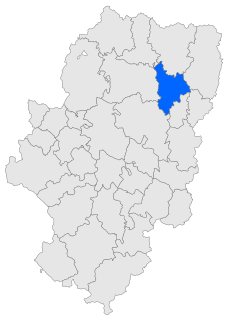
Somontano de Barbastro is a comarca in Province of Huesca, Aragon, Spain.
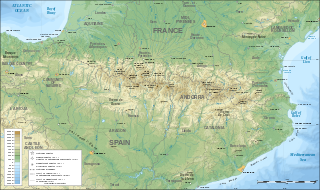
The Sierra de Guara is a mountain massif in the province of Huesca, the most northerly province in the autonomous community of Aragon, Spain. Its highest point is Tozal de Guara.
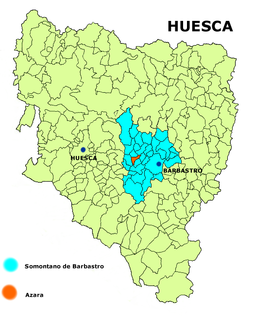
Azara is a municipality in the province of Huesca, Spain. In 2018, it had a population of 174 inhabitants. It is located in the middle of a valley named after Alferche, to the right of the La Clamor Canyon, surrounded by sandstone the highest among which is Peña de Santa Margarita, 40 km away from Huesca.

The Sierra y Cañones de Guara Natural Park is a Spanish Natural park in the Sierra de Guara mountain range, located in the Province of Huesca, Aragon, northern Spain. It was established in 1990.
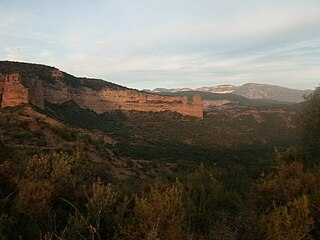
The Peña Falconera or Huevo de Morrano is a rock formation near the village of Morrano, northwest of Somontano de Barbastro, Province of Huesca.

In 1063, at the Synod of Jaca, under the auspices of King Ramiro I of Aragon and the presidency of the Archbishop of Auch, the ancient diocese of Huesca, whose seat was under Muslim Zaragozan control, was reestablished in the town of Jaca, which became "an instant city". Besides the archbishop of Auch, Austind, the synod was attended by other prelates of Gascony, Navarre and Aragon. Much of Jaca's early settlers were Gascons at this time. The synod determined the boundaries of the diocese, both present and future, that is, after its reconquista. Much of the new territory was taken at the expense of the diocese of Roda, whose bishop, Raymond, later litigated over Alquézar. It placed the canons of Jaca under the Augustinian Rule, and also introduced that rule into the royal chapels of Siresa, Loarre, Montearagón and Alquézar. Unspecified reform was introduced into the monasteries of San Juan de la Peña and San Victorián de Huesca, and the Roman rite replaced the old Visigothic liturgy. A new, eclectic cathedral, San Pedro Apóstol, was consecrated in Jaca.
Aniés is a town in the Hoya de Huesca in the municipality of La Sotonera, Huesca Province, Spain.
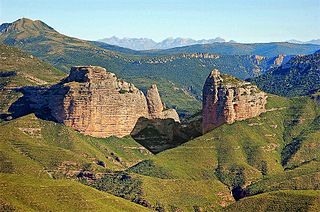
Salto de Roldán is a rock formation about 25 km (20 mi) north of Huesca in High Aragon, northern Spain, in the foothills of the central Pyrenees. It lies in the westernmost part of Sierra y Cañones de Guara Natural Park. It consists of several large outcrops of almost bare rock standing clear of the surrounding landscape.




















